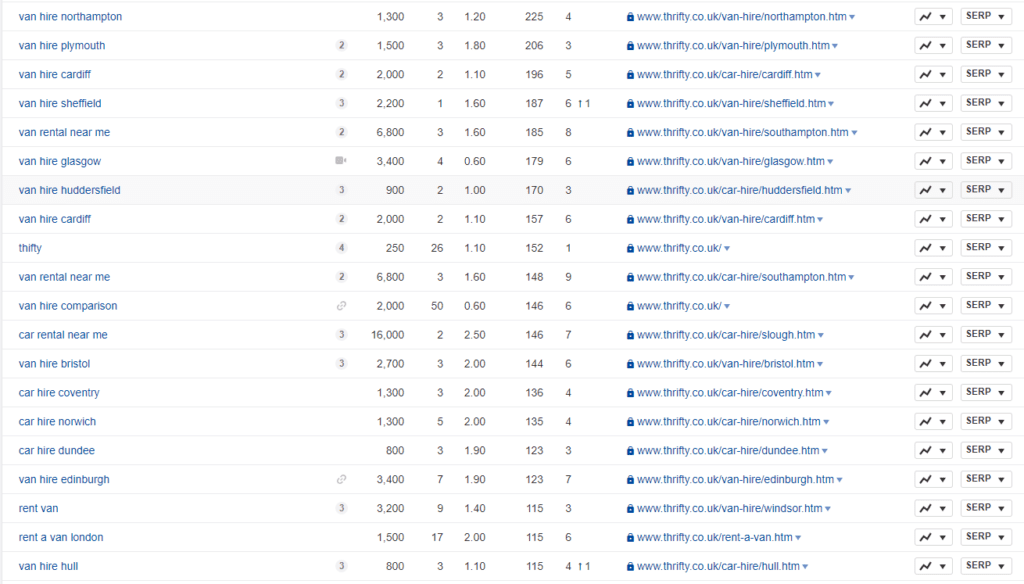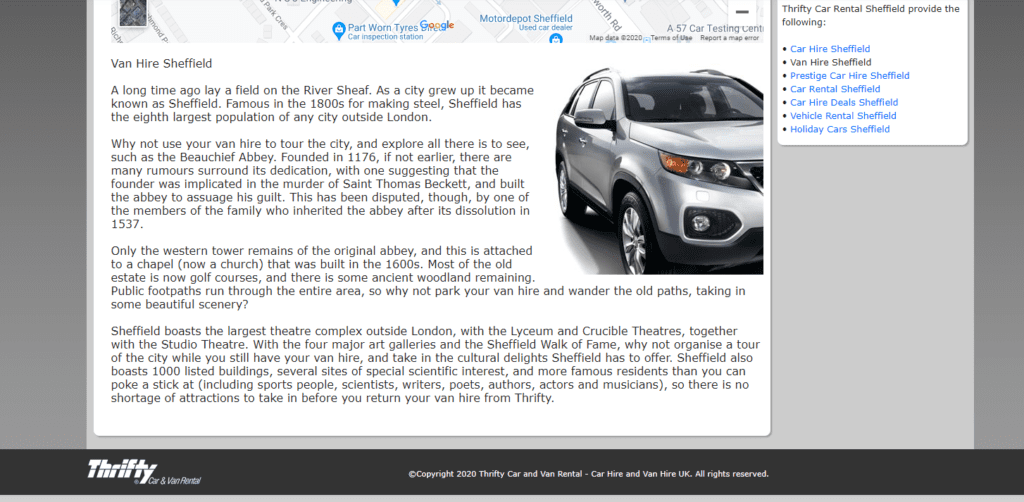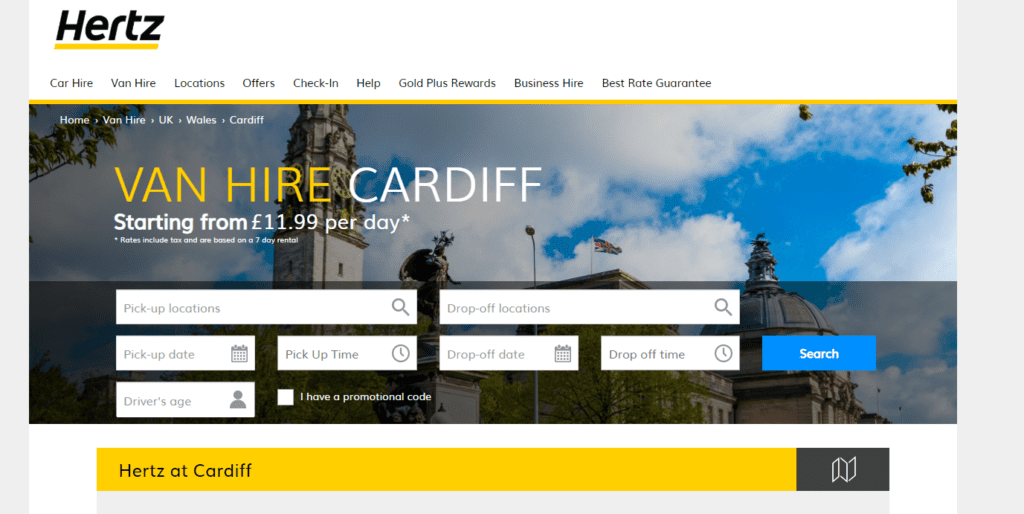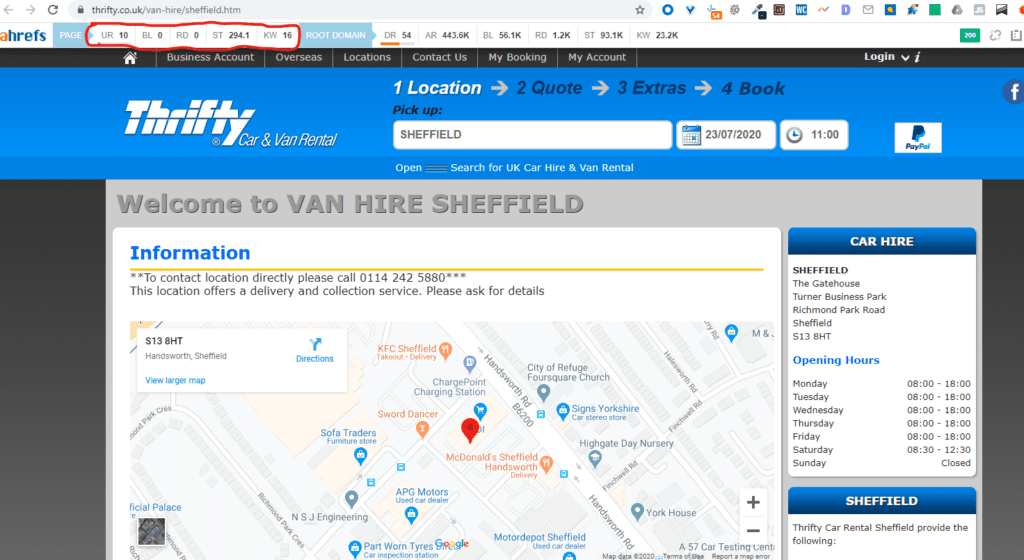Last year, we performed an industry report on the car hire industry to see who’s performing the best online. As you’d expect, there were winners and losers, but one brand stood out like a sore thumb…
Thrifty had seen an impressive uplift in visibility, despite the bearish -49% drop in the industry overall. Even though a lot of car hire brands were crashing and burning, they had managed to squeeze a win out of the situation.
When we took a look at the keywords they were predominantly ranking for, it became clear what their strategy was. Better yet, when we looked at the SERPs for these keywords, the competition was low. This same strategy can therefore be used for smaller car rental brands looking for their big break in 2020.
Location, Location, Location
The car hire industry is all about locations. People search for car and van rental in the area closest to them, which in most cases is usually the city or town they live in. Thus, it is important that Google shows them a relevant local result once they’ve clicked ‘search’.
This leaves an interesting opportunity for car and van hire brands to jump in and niche down on their locations. The more specific you can get in your location pages, the better you’ll perform on those smaller searches the big brands aren’t targeting.
Although these searches hold smaller search volume, they accumulate and contribute to a significant boost in online visibility. It’s all about seeing the bigger picture.
This, in a nutshell, is the bread and butter of Thrifty’s strategy. They have been building niche location pages and ranking them in low competition SERPs. Although they’re by no means ranking in position 1 for these terms, they are competing against some tough competition, such as Enterprise.

Your Locations Folder is your Biggest Asset
If you look at the above screenshot, you’ll see what I’m getting at.
The majority of their best ranking keywords are very location-based search queries. They seem to have created a separate page for every UK city they operate in (including Scotland and Wales) and are ranking very well as a result of it.
This is something any car or van rental brand could do to quickly get a boost in their visibility and start competing with the big boy brands on Google.
Low Competition Opportunities
One of the glaring findings when analysing the keywords Thrifty is ranking for is that the keywords have such a low barrier to entry. Many of the keywords have competition ratings of 2 and 3, meaning it won’t take a lot of juice or authority to get to the top spots.
In fact, when you take a random page from Thrifty, that statement holds more weight.
Take their Sheffield van hire page, for example:
Despite ranking well for the head term ‘sheffield van hire’, they have no backlinks at all on this page. To put it into perspective for you, this keyword gets 2000+ searches a month and Thrifty are ranking with ease without any external authority.
Even when analysing the SERPs, the low competition nature of these keywords is further amplified.
Take a look at the top 10 results for ‘cardiff van hire’:

Although there are a few big players, such as Enterprise and Hertz, look at the websites nearer the bottom.
There is a website with a DR of 1 ranking in position 9 for this term. And if you want to look further up, there is a website with a DR of 29 ranking in position 3.
The majority of the brands on the report have DRs higher than 29 and would have a much better chance at ranking nearer the top with little to no effort.
For all the marketing people and car rental brands reading this now, nearly all the SERPs look this way for niche location-specific keywords.
This is an opportunity you can’t afford to bypass.
Creating Potent Pages that Rank Fast
Once you’ve identified the locations you want to target, its time to build the folders and pages associated with these so you rank for them asap.
To be honest, this is the long-winded part. You’ll need to create a page for [location] car hire and [location] van hire, as well as any other services you have.
I won’t get into the step-by-step process of creating a sub-folder for locations and separate location-specific pages. Save that for your tech team.
The part that needs to be discussed now is what you’ll be putting on these pages to get them ranking.
Creating Copy that Google Loves
Google thrives off content. You need to give it as much context and information about the page as possible, so it knows what the page is about and how to rank it.
Thrifty has grasped this (to a degree) and included copy on their niche location pages.

However, I wouldn’t say Thrifty is doing the best when it comes to on-page optimisations. There is a lot to improve on and, in my opinion, the copy on their pages is a little shallow and random. Plus, as they have similar copy on each location page (depending on the location), I’d be concerned about cannibalisation issues.
When you’re creating copy for your location pages, it’s best to also include high-quality imagery and breaks in the copy to aid eye flow and conversions.
Thrifty’s pages may rank but I’d be curious to see if this copy actually serves any purpose when it comes to creating customers.
Nonetheless, when producing copy for your location pages, aiming for 500-750 is best. Include internal links to other, relevant pages and make sure there are call-to-actions in optimal positions.
Conversion Optimised
You not only want a page to rank, you also want it to convert. There is no point spending the time, energy, and money getting a page to the top of Google if it’s not going to earn you money.
The pages you create for specific locations need to be optimised for conversions.
That is, they need to be structured so they capture leads, send them down your funnel, and create customers.
Simple ways to achieve this are by including a direct call-to-action above the fold, displaying key benefits of using the service, as well as guarantees, social proof, and simple forms.
A good frame of reference would be someone like Hertz:
Although their pages aren’t perfect, they have a form directly above the fold, along with a benefit (“£11.99 per day”) and a form to capture leads.
Having something like this is a perfect way to send people down your funnel and create profit fast.
This is a Simple Yet Forgotten Technique
The above technique of creating location-specific pages is nothing new to most car rental brands, yet the majority of the brands on the report are executing it poorly.
As a result, they’re being outranked by low authority brands who didn’t even make it into our analysis.
The competition is so low for keywords for specific cities (and even towns) that it would be insane for any car and van rental brand to let this opportunity slide.
If you need help setting up location pages on your car rental site and want the heavy lifting done for you, get in touch with us asap and we’ll create a proven plan that’ll get you on the first page in no time.

